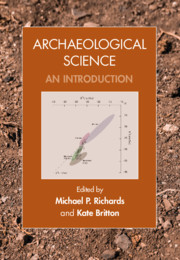Book contents
- Archaeological Science
- Archaeological Science
- Copyright page
- Contents
- Figures
- Tables
- Contributors
- Acknowledgements
- Part I Introduction
- Part II Biomolecular Archaeology
- Part III Bioarchaeology
- Part IV Environmental Archaeology
- Part V Materials Analysis
- 14 Ceramics
- 15 Glass
- 16 Metals
- 17 Lithics
- Part VI Absolute Dating Methods
- Index
- References
17 - Lithics
from Part V - Materials Analysis
Published online by Cambridge University Press: 19 December 2019
- Archaeological Science
- Archaeological Science
- Copyright page
- Contents
- Figures
- Tables
- Contributors
- Acknowledgements
- Part I Introduction
- Part II Biomolecular Archaeology
- Part III Bioarchaeology
- Part IV Environmental Archaeology
- Part V Materials Analysis
- 14 Ceramics
- 15 Glass
- 16 Metals
- 17 Lithics
- Part VI Absolute Dating Methods
- Index
- References
Summary
Lithic analysis is primarily about understanding the factors that lead to variability in stone tool assemblages. These include properties of the raw materials used to make stone tools and the ways the sources for these raw materials were managed; the techniques and strategies used to reduce these materials into useable tools; the functional needs these tools were designed to meet; and stylistic preferences. Underlying these factors is fracture mechanics, the basic physical laws, which make stone knapping possible. Through the study of these various factors and how they each contribute to formation of a lithic assemblage, archaeologists hope to say something about prehistoric behavior.
- Type
- Chapter
- Information
- Archaeological ScienceAn Introduction, pp. 387 - 404Publisher: Cambridge University PressPrint publication year: 2020



